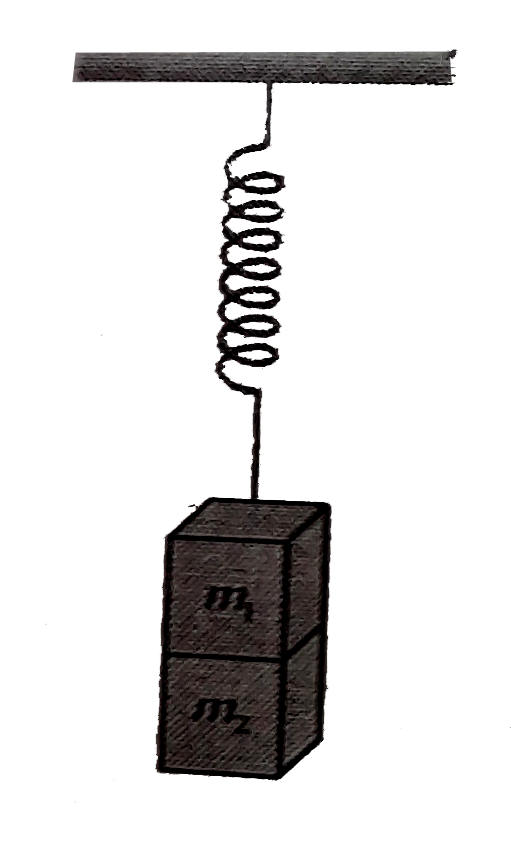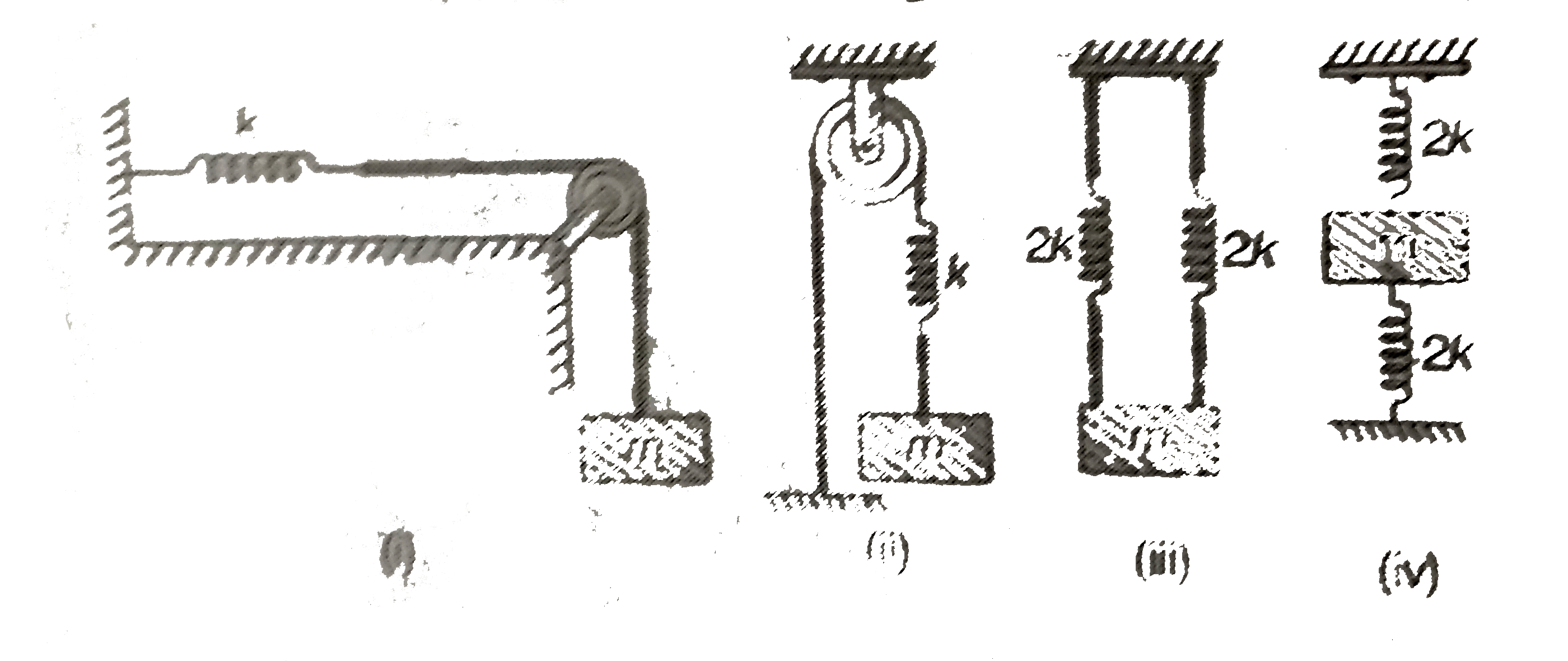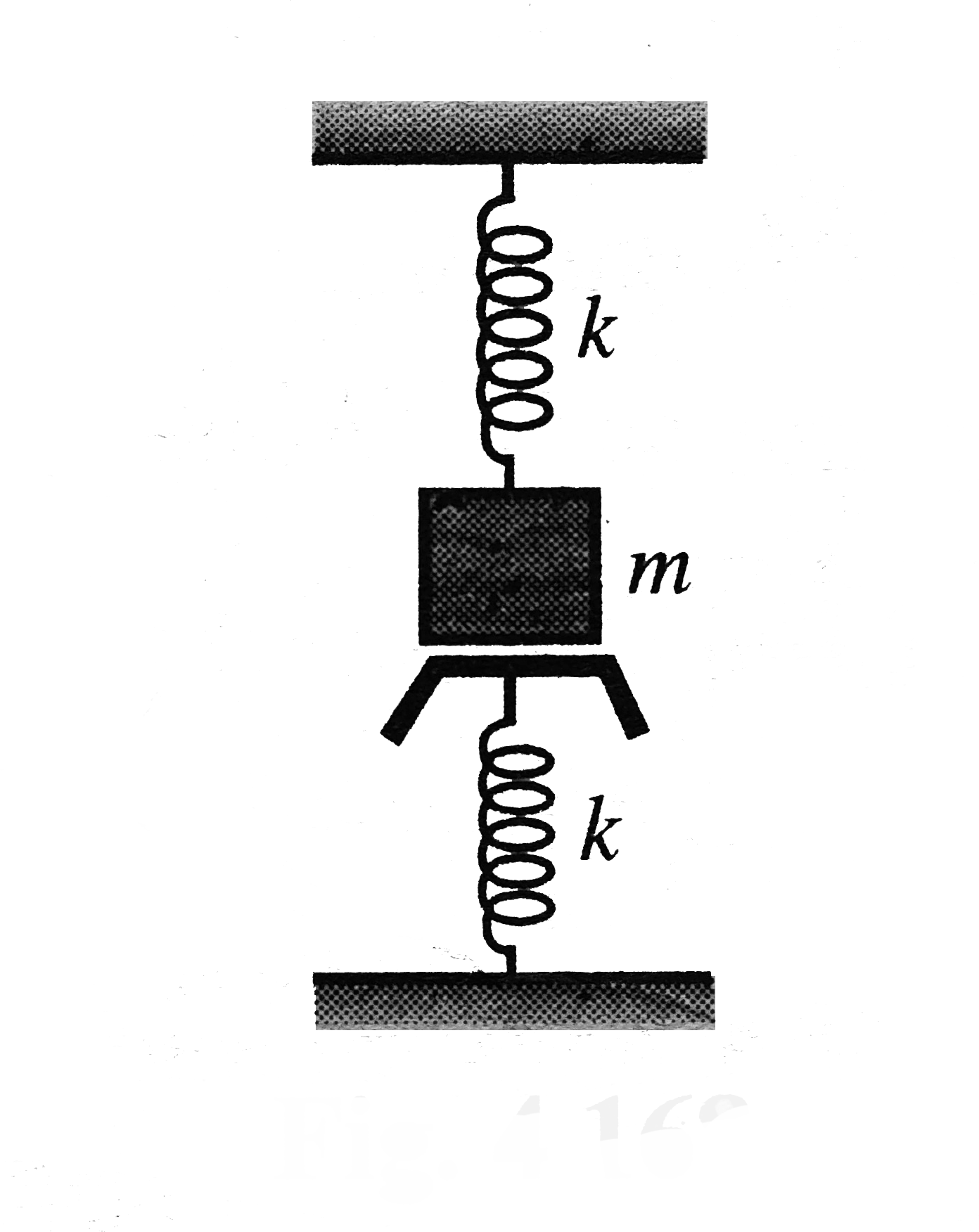Two masses M and m are suspended together by massless spring of force constant -k. When the masses are in equilibrium, M is removed without disturbing the system. The amplitude of oscillations.
Mgk
mgk
(M+m)gk
(M−m)gk
The correct Answer is:A
To solve the problem step by step, we will analyze the situation with the two masses suspended by a spring and how the removal of one mass affects the oscillations of the system.
Step 1: Understand the Initial Setup
We have two masses, M and m, suspended from a spring with a spring constant k. When both masses are in equilibrium, the spring stretches due to the combined weight of both masses.
Hint: Identify the forces acting on the system when both masses are attached.
Step 2: Determine the Initial Equilibrium Position
The force due to gravity acting on the system is (M+m)g. At equilibrium, the spring force equals the gravitational force:
kx0=(M+m)g
where x0 is the initial elongation of the spring.
Hint: Use the equilibrium condition to relate the spring force and the gravitational force.
Step 3: Solve for Initial Elongation x0
From the equilibrium condition, we can solve for x0:
x0=(M+m)gk
Hint: Rearrange the equation to isolate x0.
Step 4: Remove Mass M
Now, we remove mass M from the system. The only mass left is m. The new equilibrium position will now be determined by the weight of mass m.
Hint: Consider how the removal of mass M changes the forces acting on the spring.
Step 5: Determine the New Equilibrium Position
The new force due to gravity acting on the remaining mass m is mg. The new equilibrium position x1 can be found using:
kx1=mg
Solving for x1:
x1=mgk
Hint: Again, use the equilibrium condition for the new setup with only mass m.
Step 6: Calculate the Amplitude of Oscillations
The amplitude of oscillations after removing mass M is the difference between the initial elongation x0 and the new elongation x1:
A=x0−x1
Substituting the values we found:
A=(M+m)gk−mgk
This simplifies to:
A=(M+m−m)gk=Mgk
Hint: Simplify the expression carefully to find the final amplitude.
Final Answer
The amplitude of oscillations after removing mass M is:
A=Mgk
We have two masses, M and m, suspended from a spring with a spring constant k. When both masses are in equilibrium, the spring stretches due to the combined weight of both masses.
The force due to gravity acting on the system is (M+m)g. At equilibrium, the spring force equals the gravitational force:
kx0=(M+m)g
where x0 is the initial elongation of the spring.
From the equilibrium condition, we can solve for x0:
x0=(M+m)gk
Now, we remove mass M from the system. The only mass left is m. The new equilibrium position will now be determined by the weight of mass m.
The new force due to gravity acting on the remaining mass m is mg. The new equilibrium position x1 can be found using:
kx1=mg
Solving for x1:
x1=mgk
The amplitude of oscillations after removing mass M is the difference between the initial elongation x0 and the new elongation x1:
A=x0−x1
Substituting the values we found:
A=(M+m)gk−mgk
This simplifies to:
A=(M+m−m)gk=Mgk
The amplitude of oscillations after removing mass M is:
A=Mgk
Topper's Solved these Questions
- SIMPLE HARMONIC MOTIONBOOK - DC PANDEY ENGLISHCHAPTER - SIMPLE HARMONIC MOTIONEXERCISE - JEE Advanced
34 Videos
- SIMPLE HARMONIC MOTIONBOOK - DC PANDEY ENGLISHCHAPTER - SIMPLE HARMONIC MOTIONEXERCISE - More than one option is correct
50 Videos
- SIMPLE HARMONIC MOTIONBOOK - DC PANDEY ENGLISHCHAPTER - SIMPLE HARMONIC MOTIONEXERCISE - Exercise 14.4
4 Videos
- SEMICONDUCTORS AND ELECTRONIC DEVICESBOOK - DC PANDEY ENGLISHCHAPTER - SEMICONDUCTORS AND ELECTRONIC DEVICESEXERCISE - More than One Option is Correct
3 Videos
- SOLVD PAPERS 2017 NEET, AIIMS & JIPMERBOOK - DC PANDEY ENGLISHCHAPTER - SOLVD PAPERS 2017 NEET, AIIMS & JIPMEREXERCISE - Solved paper 2018(JIPMER)
38 Videos
Similar Questions
Two masses m 1 and m 2 are suspended together by a massless spring of constant K . When the masses are in equilibrium, m 1 is removed without disturbing the system. The amplitude of oscillations is

View SolutionTwo masses 8 kg 4 kg are suspended together by a massless spring of spring constant 1000Nm−1 . When the masses are in equilibrium 8 kg is removed without disturbing the system . The amplitude of oscillation is
View Solution
Knowledge Check
Two masses m1andm2 are suspended together by a massless spring of constant k. When the masses are in equilibrium, m1 is removed without disturbing the system. Then the angular frequency of oscillation of m2 is
A√(k/m1)B√(k/m2)C√[k(m1+m2)]D√[k/(m1m2)]
Two masses m1 and m2 are suspended together by a massless spring of constant K. When the masses are in equilibrium, m1 is removed without disturbing the system. Then the angular frequency of oscillation of m2 is -

View SolutionTwo masses m1andm2 are suspended together by a massless spring of constant k. When the masses are in equilibrium, m1 is removed without disturbing the system. Then the angular frequency of oscillation of m2 is
View SolutionTwo masses m1=1kgandm2=0.5kg are suspended together by a massless spring of spring constant 12.5Nm−1. When masses are in equilibrium m1 is removed without disturbing the system. New amplitude of oscillation will be
View SolutionA block of mass m is suspended by different springs of force constant shown in figure.

View SolutionA block of mass m hangs from a vertical spring of spring constant k. If it is displaced from its equilibrium position, find the time period of oscillations.
View Solution
A mass m is suspended from a spring of force constant k and just touches another identical spring fixed to the floor as shown in the fig. The time period of small oscillations is
View SolutionA block of mass m suspended from a spring of spring constant k. Find the amplitude of S.H.M.
View Solution
